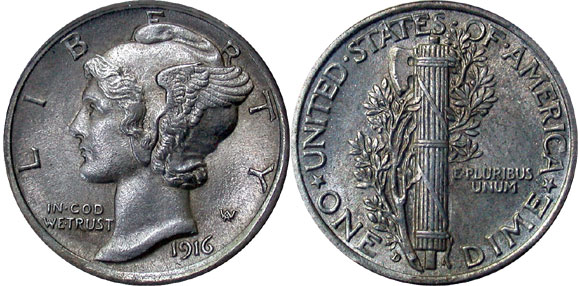Background and History
The 1916-D Mercury Dime (Buy on eBay) represents one of the most well-known key date coins of the 20th century. During a time when the hobby of coin collecting was increasing in popularity, many beginning collectors sought to acquire the coin from circulation to complete their sets. With a mintage of just 264,000 pieces, the likelihood of encountering the issue in loose change was remote but not impossible. Whether or not the search was successful, the thrill of the hunt and the appreciation for low mintage issues would provide a shared foundational experience for a generation of collectors.

The design for the Mercury Dime was created during the so-called Renaissance era of United States coinage. During his Presidency, Theodore Roosevelt began the process of redesigning the various denominations with the goal of elevating America’s circulating coinage to objects of beauty and expressions of national identity. The gold denominations would be redesigned in 1907 and 1908, followed by the cent in 1909, but the silver dime, quarter, and half dollar would have to wait until 1916. These denominations all carried similar designs created by Charles E. Barber which had been introduced in 1892. Under statute, the designs were required to be used for a minimum of 25 years before they could be changed. Once the mandatory period had passed, a competition was held to find suitable designs for each of the three denominations. Designs created by Adolph A. Weinman would be selected for both the dime and half dollar, with a design by Hermon A. MacNeil selected for the quarter.
Weinman’s design for the dime featured the head of Liberty facing to the left and wearing a Phrygian cap adorned with wings to symbolize freedom of thought. The inscription LIBERTY appeared widely spaced above, with IN GOD WE TRUST to the left and the date at the truncation of the neck. The reverse design featured Roman fasces, or an axe tied to a bundle of rods, with an olive branch intertwined. The inscriptions UNITED STATES OF AMERICA and ONE DIME appeared surrounding, with E PLURIBUM UNUM to the right of the fasces. Once released, the public immediately associated with obverse design with the Roman god Mercury and referred to the new coins as “Mercury Dimes.”
Coin Mintage
The mintage of the 1916-D Mercury Dime is by far the lowest of the series and in fact the lowest mintage for a circulating dime of the entire 20th century. Whereas the Philadelphia Mint would strike more than 22 million dimes featuring the new design, the Denver Mint struck just 264,000 examples which were delivered in November 1916. It is believed that a decision was made at this time to focus production on the quarter for the duration of the year and forgo other denominations. This is supported by delivery reports which show a sudden increase in quarters for both November and December 1916.
As coin collecting gained in popularity within the United States, the demand for the 1916-D Mercury Dime increased resulting in steadily rising prices. Unfortunately, this situation led to a relatively large number of counterfeits. This includes added mint marks (adding the “D” mint mark to a genuine 1916 Mercury Dime struck at the Philadelphia Mint) as well as struck counterfeits. Examining the style of the mintmark is an important method for determining if a given coin is genuine. It must be noted that various mintmark styles exist, making professional authentication strongly advisable for coins in all grades.
Finest Known and Values
The majority of examples of the 1916-D Mercury Dime immediately went into circulation after being struck, resulting in a relatively small proportion of uncirculated survivors. Coins graded MS-65 and higher are particularly difficult to find. Circulated examples are more available, but remain expensive, due to the high demand for this rare issue.
The value of heavily circulated examples of this key date in very low grades can be as much as $500 each. For lightly circulated pieces, the price shows a strong increase. As an example, a nicely circulated VF specimen, certified by PCGS, can easily bring $3,000 to $4,000 at public auction.
The finest known specimens with the “Full Bands” designation (determined by the sharpness of the bands in the fasces on the reverse) are ten pieces graded MS-67 FB by PCGS and four graded MS-67 FB by NGC. It appears that these numbers are influenced by at least a few resubmissions, with fewer coins than the indicated populations actually available. One of the coins graded PCGS MS-67 FB displaying attractive original toning and carrying a CAC verification sticker sold for $204,000 in 2020. Another example graded PCGS MS-67 FB with considerably less eye-appeal sold for $96,000 in 2018, showing the large price disparity that often exists for coins in the same numerical grade.
While the majority of uncirculated 1916-D Mercury Dimes have been certified with the FB designation, there are also some high-grade examples without the designation. These coins usually trade for much smaller premiums compared to examples certified with Full Bands, although offerings are scarce. PCGS has graded a single MS-66 as the finest example with just a handful graded MS-65. NGC has graded two examples in MS-66 as the finest without the FB designation.

